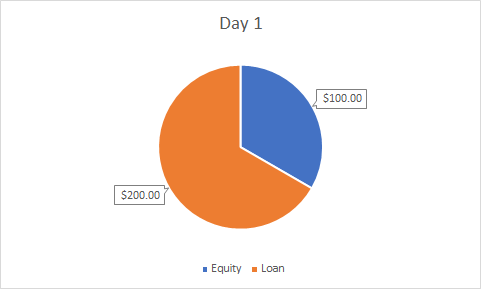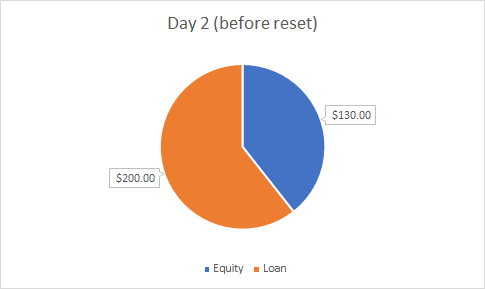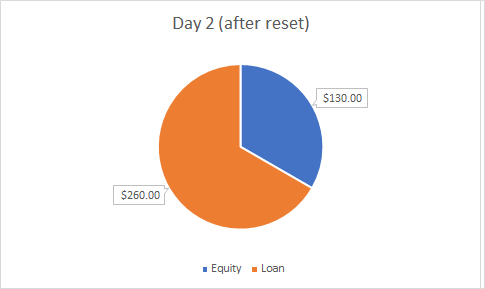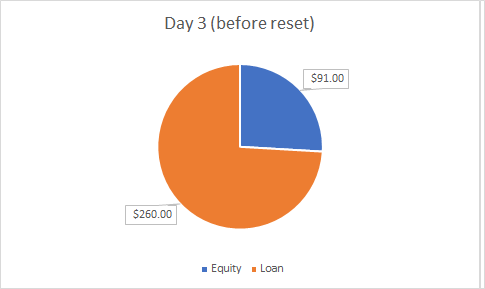Since its trough on March 9, 2009, when the S&P 500 closed at 676.53, the stock market has almost quintupled in value. That’s an annualized growth rate of more than 15%! And while we are thinking about these tasty returns, the painful losses of the 2008 recession quickly disappear in the rearview mirror. A fearless investor might ask: can we make even more? The answer is yes, but the devil is in the details.
Applying Leverage
The idea is to further boost the stock market’s returns by applying leverage. In a nutshell, we borrow money, taking advantage of the low-interest rates. Next, we invest this money in the stock market and pocket the difference between the stock gains and the interest paid. Voila, we have just levered up our returns.
We can apply leverage in multiple ways. Our broker happily borrows us money in a margin account, allowing us to leverage up by a factor of two or even more, depending on the account type. But how about these leveraged ETFs carrying terms like UltraPro or Bull 3x in their names?




Leveraged ETF Mechanics
Leveraged ETFs are complex products, and it is important to understand their inner mechanics before using them. Let’s walk through an example:
- On day 1, we buy a 3x leveraged ETF for $100. This implies taking a loan for $200 so that we control assets worth $300.
- On day 2, the value of our assets rises by 10%. Our loan is not affected by this, so our equity increases by 30%. Nice! But because our equity grew faster than the assets, our leverage is now less than 3x.
- The ETF now performs its daily reset to adjust the leverage back to 3x. To do so, the ETF purchases additional shares resulting in a total of $390 in assets.
- On day 3, our assets lose 10% of their value. Again, our loan is not affected by this, so our equity decreases by 30%. Similar to before, our equity moved faster than the total asset value, and our leverage now exceeds a factor of 3x.
- Again, the ETF performs its daily reset. This time, the ETF sells shares to adjust the total assets to $273. With this exposure, the leverage is back to 3x.
Volatility Decay
Even though the market (almost) returned to where our example started, our investment in the 3x ETF lost 9% of its value. Is our math incorrect? Unfortunately, it is not. Leveraged ETFs promise their performance only for a single day but not for longer periods. The money lost in our example is a consequence of the ETF’s daily reset leading to a path dependency called volatility decay or beta slippage. This decay increases with rising volatility and is dependent on the path the price takes.
Because of this decay, leveraged ETFs must be used with extreme caution and require constant supervision. In particular, and as illustrated by our example, we need to avoid holding leveraged ETFs in times of high volatility. Therefore, leveraged ETFs are not suitable for buy-and-hold portfolios. Instead, leveraged ETFs require tactical asset allocation.
Reducing market exposure when volatility rises comes naturally with volatility-targeting strategies. Therefore, this type of strategy is a good match for using leveraged ETFs.
Blowing Up the Account
But there is another significant risk to consider: the risk of blowing up the account. Thanks to the leverage, it is possible for losses to exceed our invested equity. Here is an example:
- Total Asset Value: $300
- Equity: $100
- Loan: $200
If on the next day the market drops by 33%, the situation is as follows:
- Total Asset Value: $201
- Equity: $1
- Loan: $200
We just lost everything. To avoid bankrupting our account, we should not get too greedy but apply leverage sparingly instead. Limiting the leverage has additional benefits: By keeping the total leverage low and constant, we counteract the ETF’s daily reset. This helps to limit the volatility decay.
It is worth pointing out that there is a difference between leveraging our account by trading on margin versus holding leveraged ETFs. When we trade on margin, we can very well blow up our account as described before. When we use leveraged ETFs, this risk is passed on to the issuer of the ETF. Instead of blowing up our own account, the ETF may suddenly close. History shows that this risk is not hypothetical.
Avoiding High Volatility
We have seen above why it is important to avoid holding leveraged ETFs through periods of high volatility. But how do we do that?
The simplest method to determine volatility is to calculate it from historical data points. Because volatility can only be determined over a period, not a singular moment in time, we introduce lag by doing so. This lag might pose a disadvantage in fast-moving markets, but our experience still shows good results. We, therefore, like to use historical volatility as our main gauge to control market exposure.
But what if this lag cannot be tolerated? For these occasions, it is good to have a fail-safe: The VIX term structure. Based on the pricing of VIX futures pricing, we can determine implied volatility for 30 days and 1 year and their relationship to each other. Typically, VIX futures are in contango, meaning that later dates are priced higher. But in times of stress, this relationship often reverses, leading to backwardation. The prices of VIX futures can be seen as a peek into options trader’s brains and often help anticipate future moves. Our market indicators page includes a useful chart for the VIX term structure.
Avoiding Deep Drawdowns
Market declines often come in clusters. Therefore, it is a good idea to remove leverage when markets are moving down. How can we achieve that? Like before, we are using two separate mechanisms.
The first method is based on the rolling 12-month drawdown. If this indicator peaks, we remove our leverage. This way, we can avoid the outsized losses that can occur due to the unhealthy combination of leverage and volatility decay.
Our second method uses macro-economic indicators. While the economy is only loosely related to the stock market, we feel that it is helpful to remove leverage when approaching a recession. There are many different methods of determining recession periods. We like the so-called Sahm-Rule, due to its simplicity. This method is based on unemployment numbers and has worked beautifully since 1960. To reduce the lag, we calculate our indicator from weekly unemployment numbers.

Pick Me Up
We have seen that leveraged ETFs are no silver bullet to boost your portfolio returns. We need to be mindful of their volatility decay, and we need to be cautious not to blow up our account. In particular, we want to:
- Apply leverage sparingly: 130% total exposure is probably enough.
- Apply leverage to instruments with limited volatility, e.g., broad indices.
- Remove leverage when volatility rises too much.
- Remove leverage when the account suffers large drawdowns.
- Don’t leave the leveraged ETFs unattended: monitor daily.
We have combined all of these concepts in our latest premium strategy, Pick Me Up. This strategy beats the S&P 500 in most years while at the same time offering a lower risk profile.

Rain or Shine
But using leveraged ETFs is not limited to attempts of ‘beating the market.’ Our Rain or Shine strategy aims to make investing a smoother experience and let you sleep better at night. To achieve this, we are taking a different approach:
- start with a conservative and low-volatility asset allocation
- add an active management layer to further reduce risk
- leverage up to achieve the desired returns
Of course, we are using similar precautions to avoid the risks associated with using a leveraged ETF.
We continuously research new portfolios. If you are looking for a more aggressive approach to applying leverage, see our article on aggressively leveraged ETF portfolios.
